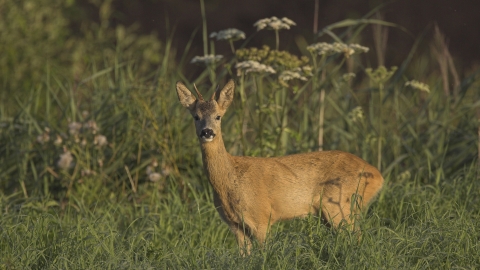
Roe Deer - Brian Phipps
Location
Know before you go
Dogs
Visit the 'Dog walking on reserves' page in the Contact section for more information.
When to visit
Opening times
Open at all timesBest time to visit
April to JulyAbout the reserve
This site is a mix of grassland and ancient, semi natural woodland with a wide range of wildlife.
The grasslands in the reserve are plant rich and appear to have been managed as hay meadows for some considerable time. There are five individual small meadows. These meadows are good place to get to know some of our commoner grasses. Look out for Crested Dog’s-Tail, Creeping Fescue, Yorkshire Fog and Sweet Vernal Grass amongst many others. Ribwort Plantain, Red Clover and Common Knapweed grow abundantly as does Devil’s-Bit Scabious and Meadow Vetchling. Scattered through the meadows are Sneezewort, Self-heal, Slender St. John’s-wort, Common Spotted Orchid, Yellow Rattle and Cowslips. In the wetter sections of the meadows Soft Rush, Hard Rush, Fleabane and Carnation Sedge are abundant in places. Species-rich hedgerows surround and bisect all these small fields.
Much of the eastern and southern sections of the reserve are wooded, with one section fenced off and managed as wood pasture. Wood pasture is a lightly wooded area with grass growing beneath the trees and with livestock put in periodically to graze.
Most of the oldest and bigger trees in these woodlands were apparently felled during the Second World War and only a few large Pendunculate Oak and Ash remain. There are some biggish Silver Birch and lots of Hazel as well as Field Maple, Hawthorn, Blackthorn and Holly. Less common shrubs include Spindle, Guelder Rose and Alder Buckthorn. There is at least one large Wild Service Tree to be found in the woodland.
The woodland ground flora is rich and dominated in places by Bluebell and Dog’s Mercury. Wood Anemone, Wood Sorrel and Sweet Woodruff also occur frequently.
Dormice inhabit the woodland and hedgerows and there is Badger activity throughout the reserve Roe deer are frequently seen. The woodland supports a rich bird community with Nuthatch, Treecreeper, Great Spotted Woodpecke, Coal Tit and Marsh Tit all nesting. Pied Flycatchers, Redstarts and Wood Warblers have all been recorded as summer visitors.
The reserve provides good habitat for invertebrates, particularly those woodland insects that require good nectaring sites which they find out in the open flowery meadows. A range of wood edge and meadow butterflies has been recorded on the reserve, including Green Hairstreak, Brown Hairstreak and Silver-Washed Fritillary.
Reserve conservation management – Coppicing has been re-instated in order to benefit the herb layer, encourage the open woodland butterflies such as the silver washed fritillary, and maintain and increase the dormouse population. Blocks of the woodland will be thinned to allow more light to the ground, thereby encouraging the natural regeneration of the herb layer and the next generation of standard trees.
History and Archaeology – The ruined Farm Wood Cottage is not listed, but is regarded as a historic structure by Somerset County Council Historic Environment Service. The remaining buildings consist of an old stone byre with lean-to shelter, stone and brick kennels, pig sties, a wooden shed and a more recent open-fronted barn of corrugated iron sheets. The older buildings are thought to be the remains of structures associated with use by the keeper of the local house and contain a small range of significant local historical features.
The woodland supports a rich and diverse bryophyte and lichen flora with uncommon lichen species including Arthonia vinosa, Catillaria atropurpurea, Enterographa crassa and Lecanictis premanea. A good range of fungi occur both in the woodland and fields, including the uncommon waxcaps, Hygrocybe intermedia and Hygrocybe punicea.
Geology and Soils - The reserve lies at the foot of the steep north westerly facing slope of a spur of the Blackdown Hills, which are comprised of Keuper Marl – Lower Lias clays and limestones, overlain by Upper Greensand with a cap of Tertiary Clay with Flints. Although on Keuper Marl, the reserve is covered with slope deposits consisting of chert, flint, sandstone, loose sand and marl. This variety of sediments leads to localised changes in the pH of the topsoil, but the site is mostly neutral.



